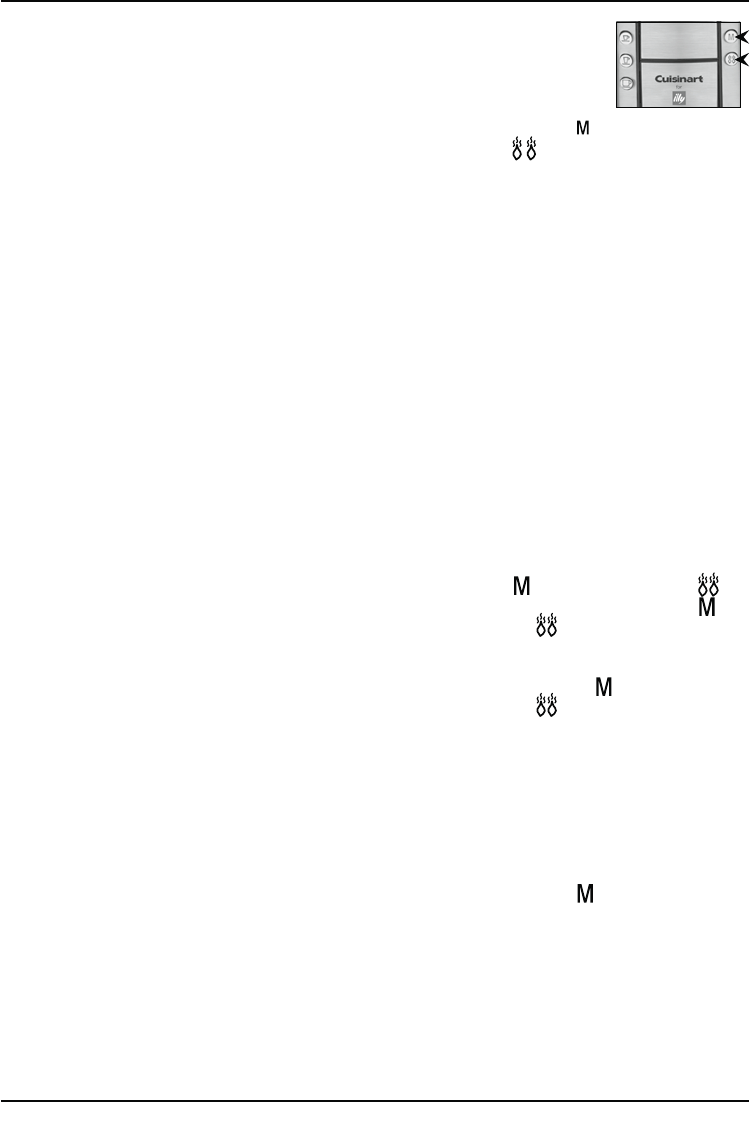
CLEANING AND
MAINTENANCE
Cleaning Used Capsule Container
Container holds approximately 10 capsules and
some residual liquid after brewing. Be sure to
empty the container of any used capsules
periodically. The container is top-shelf
dishwasher safe and may also be cleaned with
warm, soapy water.
Cleaning External Parts
We recommend regular cleaning of the
espresso maker’s external components.
Cleaning the Housing
Never immerse the machine in water or other
liquids. The housing may be cleaned with a
soapy, damp, non-abrasive cloth.
Cleaning the Drip Tray
To remove the drip tray, simply slide it toward
you, keeping it level at all times in order to
prevent spills. The drip tray and drip tray plate
are top-shelf dishwasher safe. It may also be
cleaned with a soapy, damp, non-abrasive
cloth. Do not clean drip tray with cleansers,
steel wool pads or other abrasive materials.
Cleaning the Water Reservoir
Water reservoir is top-shelf dishwasher safe.
It is normal over time for discoloration, spotting
or staining to appear in the water reservoir. This
will vary depending on the mineral content of
the bottled or filtered water used, but will not
affect the operation of the machine. However,
be sure to clean the water reservoir regularly to
minimize buildup.
Decalcification
Mineral content in water varies from place to
place. Depending on the mineral content of
the water in your area, calcium deposits or
scale may build up in your machine.
Though scale is non-toxic, it can hinder
performance. Descaling the machine will
help maintain the heating element and other
parts that come into contact with water.
For
optimal performance, descale your machine
every 3 to 6 months. It is possible with heavy
use and/or hard water for calcium to build up
faster, making it necessary to descale more
often. Some indications that it is time to
decalcify may be longer brewing times,
excessive steaming, lower coffee temperatures
and brews of less than a full cup. If you
experience any of these,
decalcify immediately. If you
do not experience any of the
above, the unit will notify you
when it is time to decalcify
by flashing the MANUAL
and
TEMPERATURE
LEDs quickly for 10
seconds after preheat/ready mode. This will
happen every time you turn on the unit or wake
up the unit from sleep mode until you decalcify.
NOTE: The unit can still be used until you
decalcify.
To begin, you will need the following:
6 ounces distilled white vinegar
6 ounce water
1 large (12 ounces) ceramic mug or container
(do not use paper cup)
Step 1: Vinegar Rinse
r 'JMMXBUFSSFTFSWPJSXJUIPVODFTPG
water and 6 ounces of white vinegar and
replace.
r 1MBDFUIFDFSBNJDNVHPSDPOUBJOFSPOUIF
drip tray.
r -JGUCSFXIFBEMFWFSUPNBLFTVSFUIFSFJT
no capsule inside.
r $MPTFUIFCSFXIFBEBOEQSFTTBOEIPME
the MANUAL
and TEMPERATURE
buttons for 3 seconds. The MANUAL
and
TEMPERATURE
LEDs will flash during
the phase of cleaning which takes
approximately 5-10 minutes. When
complete, the MANUAL
and
TEMPERATURE
LEDs will hold steady.
r %JTDBSEUIFDPOUFOUTPGUIFDFSBNJDNVHPS
container.
Step 2: Fresh Water Rinse
r 'JMMUIFXBUFSSFTFSWPJSXJUIDMFBOGSFTI
water.
r 3FQMBDFUIFDFSBNJDNVHPSDPOUBJOFS
on the drip tray.
r
Press the MANUAL
button and the unit
will dispense water for approximately 90
seconds.
r
This will clean the machine’s plumbing
and remove any residual vinegar taste.
r
The machine is now ready for normal use.
Maintenance: Any other servicing should be
performed by an authorized service
representative.
8


















